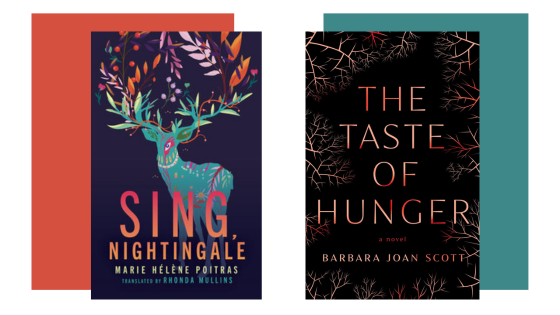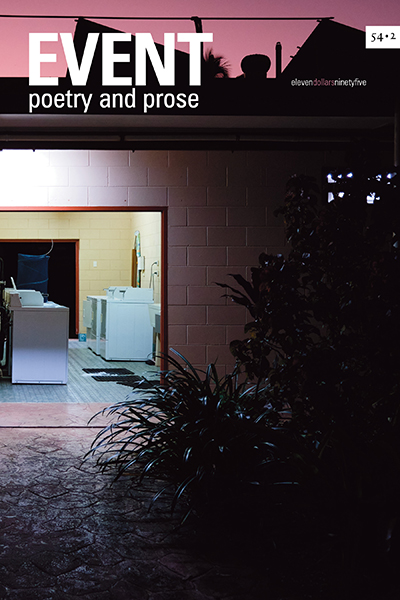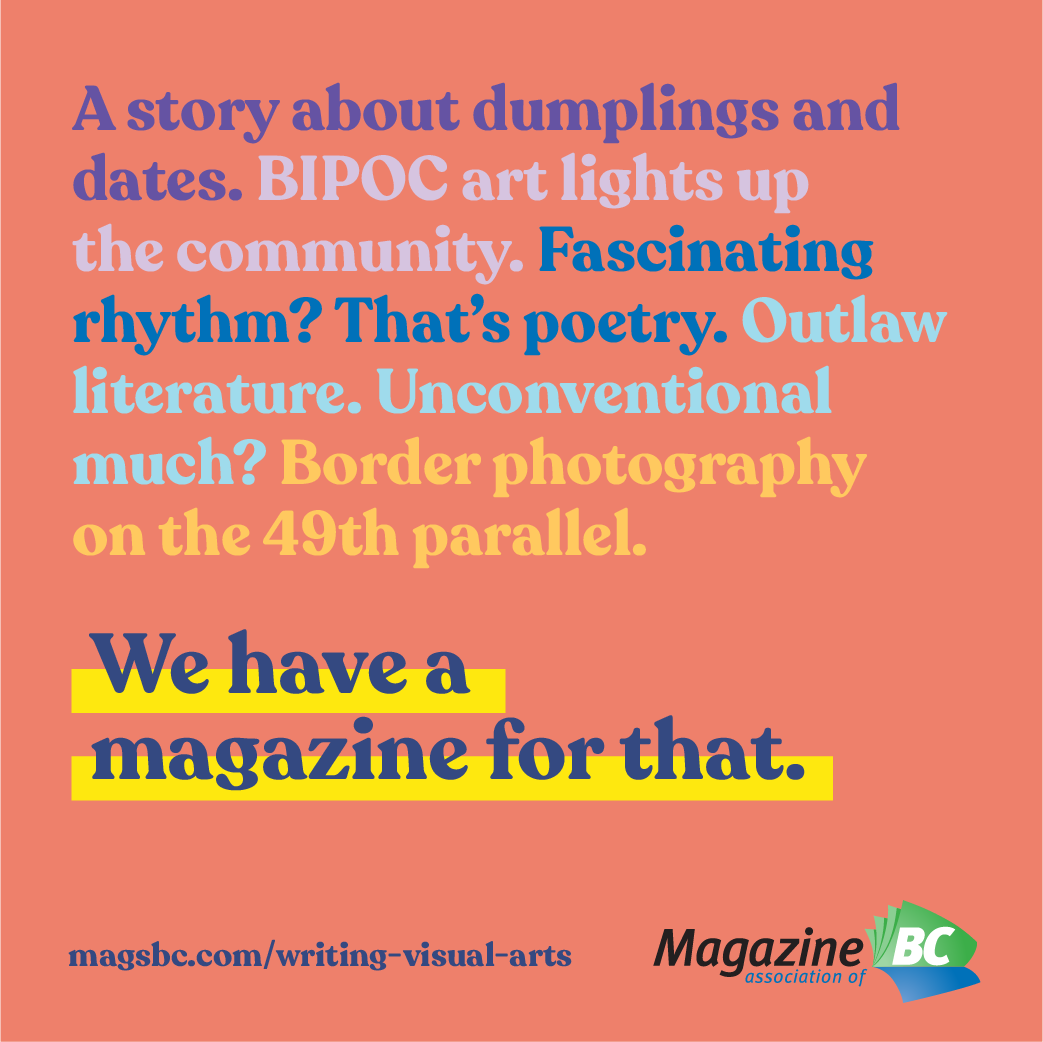Marcie McCauley Reviews New Fiction for EVENT 52/2
Marcie McCauley Reviews:
Marie Hélène Poitras, Trans. Rhonda Mullins, Sing, Nightingale, Coach House Books, 2023
Barbara Joan Scott, The Taste of Hunger, Freehand Books, 2022
Marie Hélène Poitras’s Sing, Nightingale and Barbara Joan Scott’s The Taste of Hunger contemplate familial and literary inheritance, as descendants of Anne Hébert and Jane Rule on desire and self-determination, and of M. NourbeSe Philip and Lee Maracle on womanhood and survival. Characters question the gap between their experiences and the stories they’ve been told, with all the expectations, frustrations and, sometimes, possibilities therein.
Sing, Nightingale is Rhonda Mullins’s translation of Poitras’s third novel La désidérata, whose cover features Joel-Peter Witkin’s silver print photograph ‘Imperfect Thirst.’ It depicts a bare-chested young woman in profile, wearing pearls and a beret, with a glassy-eyed eel draped across her head, fangs suspended above a bisected pomegranate. Like Poitras’s novel, the image feels simultaneously ancient and modern, the figures static and vibrant.
Poitras opens with about a hundred words to literally set a scene—there’s talk of a stage and puppets—that ends with ‘Curtain.’ The setting is the Malmaison estate in Noirax, where the Berthoumieux family has lived comfortably for generations, each patrilineal descendant exerting his will on the people, animals and land that surround him. The current owner, known to readers initially only as ‘the father,’ invites a newcomer to the estate: Aliénor, a young woman skilled at agriculture and animal husbandry. The father’s desires are many—financial, sexual, political—but Aliénor arrives animated by her own mission and proceeds to upend the long-established order of things.
Poitras’s prose is precise and evocative: ‘There are many more things to find in the forest: fruit, dreams, secrets.’ Tensions lurk: ‘What is needed is the cries of as-yet-unborn children to scare the partridges so they leap into the hand to be killed.’ The language of the hunt highlights survival, and agency ebbs and flows like desire, subverting the roles of predator and prey: ‘It’s too easy with the father; hunting by stalking is much less exciting.’ French children’s songs are interspersed throughout the text, exposing vulnerability and truncated lives. With ‘Alouette,’ for instance—‘je te plumerai, I will pluck you’—each verse erodes another body part. (Furthermore, the refrain recalls a character who conceals core elements of their being: shape-shifting, surviving.)
Thematically and atmospherically, there are echoes of Anne Hébert’s 1970 novel Kamouraska (translated by Norman Shapiro), both as the source of Poitras’s epigraph and throughout. Poitras mirrors the uneasy intimacy that Hébert establishes in her setting: ‘All the countryside around the house. Who’s out there, watching, hiding in the darkness? Spying.’ Readers familiar with Kamouraska will also anticipate acts of violence, as will readers familiar with Poitras’s 2012 novel, Griffintown.
Like Poitras, Barbara Joan Scott is invested in exploring the reverberations of familial dysfunction over generations. The Quick, her short story collection published in 2003, is populated by children seeking answers and adults longing for understanding and security. The final story illuminates a central tenet in her work: ‘I look out on the gathering darkness and I think, that’s as much as you know.’ Her voice is vivid and contemplative, meditating on the nature of being human, being alive: ‘For the truly terrible thing is not death at all, but…life that eats away at muscle until there is nothing left but bone.’ What endures, what is lost?
In The Taste of Hunger, Scott’s multiple points of view expand readers’ attachments and compassion: in this page-turner of a family saga, each character yearns for something, and each navigates the world with the burden of trauma. It’s the 1920s and 15-year-old Olena has reluctantly married an older man named Taras, a fellow Ukrainian immigrant living on the Canadian Prairies. Olena was raised by her father and his sister, Varvara, whose dreams of independence were similarly thwarted. When Olena overhears Taras telling a story about Baba Yaga and Vasilisa, Olena remarks, ‘Happily ever after. Lucky woman. Dragged back to live with an adulterer and a murderess.’
To Taras, Varvara is a Baba Yaga figure, crone-like even in middle age, who fuels his desire for new stories about young Vasilisa’s resilience. The oldest daughter, June, loves reading her book of fairy tales—‘hiding inside its grimy, weathered cover, wanting to be anywhere else, anyone else’—but, even in girlhood, June noticed that in stories ‘things rarely turned out well for the dark sister.’
Allusions to familiar stories intentionally spark readers’ desires for different endings. Taras’s struggles to navigate hardships in marriage and farming call to mind the classic Saskatchewan novel by Sinclair Ross, As for Me and My House. Olena and Taras’s turbulent marriage also recalls another prairie classic, Margaret Laurence’s The Stone Angel, which affords a woman sexual desire and agency in the absence of emotional intimacy. While pulses quicken beneath the skin, the unsaid and the unseen accumulate power.
Poitras begins her story under the canopy: ‘The surrounding forest is made of words, with secrets buried in the spaces between them and entwined around the roots.’ Scott’s novel also begins in the soil: ‘You lie in the ditch at the edge of what was once the largest slough in the district, ribs grassy and waiting, empty sockets taking in the sky.’ What’s the cost of silence, and who pays? Poitras demands specifics—‘How many infants have been abandoned in the woods? How many survived?’—and queries the inevitability of stories’ endings: ‘Who decides the goings-on in children’s songs and nursery rhymes? For instance, why hang Pierre and Jeannette?’ Her storyteller responds that we must ‘continue to sing, to write, to rebuild, to undo the knots,’ and Scott’s storytelling father, Taras, instructs June to ‘make sure your story turns out better than mine.’
Both novels contain a scene with coals burning: concrete realities for characters but also symbolic, cyclical patterns. In Sing, Nightingale, Aliénor discovers that ‘[c]ontemplating the black turning to red then to grey soothes her’; in The Taste of Hunger, Varvara ‘poured [June] some water from a stone jug over the hissing coal’ in a mug as a healing draught. Both authors underscore the significance of transformation. Singing about two lovers who are hanged doesn’t change their demise: the chorus repeats, the song endures. Poitras provokes: ‘Who is this all-powerful storyteller, who never questions their decisions, who constantly makes bad choices?’ Scott presents the story of a woman who ‘had buried herself too deep, hidden herself too well’ but also affords June the opportunity to unearth herself. These storytellers not only break silences: they alter outcomes.
In exploring the psychological and philosophical elements that underpin story, Poitras carries on the legacy of novels like Nicole Brossard’s Fences in Breathing (translator, Susanne de Lotbinière-Harwood) and Daphne Marlatt’s Ana Historic. There’s a stylistic relationship between Sing, Nightingale and Leanne Betasamosake Simpson’s Noopiming and Audrée Wilhelmy’s The Body of the Beasts (translator, Susan Ouriou). Among the novel’s woodland kinfolk are Jean-Michel Fortier’s The Unknown Huntsman (translator, Katherine Hastings) and Andrée A. Michaud’s Boundary (translator, Donald Winkler), alongside survival stories born out of Once-Upon-a-Times, like Emily Brewes’s The Doomsday Book of Fairy Tales and Julie Demers’s Little Beast (another Mullins translation).
By focusing on story and characterization, Scott writes in the tradition of Katherena Vermette’s The Break and Louise Erdrich’s The Beet Queen. The Taste of Hunger could claim kinship with Sharon Butala’s intersecting prairie novels (beginning with The Gates of the Sun) alongside ancestral stories like Dionne Brand’s At the Full and Change of the Moon and Sky Lee’s Disappearing Moon Cafe. It employs kaleidoscopic views like Lisa Bird-Wilson’s Probably Ruby and Myriam J. A. Chancy’s What Storm, What Thunder, and it echoes the reflective tone of Wendy McGrath’s Santa Rosa trilogy and Alissa York’s Effigy.
There are many relationships between Poitras’s and Scott’s novels—and other unearthed stories, besides—urging readers to ponder what is offered and received when stories are told and retold. Their bruises and burials, throats slit and throats singing, question what is created and sustained, transmitted and resisted. Scott’s story ends with bones singing in ‘one last gust of release’ and Poitras’s ends with an infant crying in concert with a buzzard. For all the focus on individual voices and autonomy, readers are ultimately compelled to attune to a chorus of stories that resonate with both ancestral inheritance and the promise of the next, fresh refrain.
—Marcie McCauley















